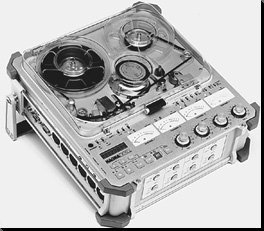Nashville, TN. Nagra U.S.A. has announced availability of v2 software for the Nagra-D portable digital recorder. The key feature among numerous changes and added features in the new software is the option of three new high-frequency sample rate selections.
The Nagra-D can now record at 96 kHz, 88.2 kHz, and 64 kHz, in addition to the machine’s original sample rates at 48 kHz, 32 kHz, and 44.1 kHz.
Other new capabilities include mirror copy, sample-accurate sync between machines, absolute time display, time-code assemble recording, tape write protection, enhancements to the search mode, and an increase in the reel-numbering scheme from 9 to 999, with auto-incrementing of reel numbers during formatting.
The Nagra-D’s new high frequency sample rates can only function with external A/D convertors, and in 2-channel mode. The digital data density required by the high sample rate is achieved by combining digital tape tracks 1 and 2 as “left” and tracks 3 and 4 as “right.” When high sample rate is selected, the inputs automatically switch to AES digital (24-bit), and the unit’s four analog inputs are disabled. As well, the high sample rate modes can only be activated by connecting the Nagra-D to a PC running its optional NADCAM software and entering a special password from the PC.
In spite of these inconveniences, the high bandwidth upgrade appears to be a ground-breaking innovation that will delight many Nagra-D users, especially with the imminent arrival of the DVD disc format with its matching high bandwidth capabilities (the various proposals on the table for DVD-Audio format include 96 kHz and 88.2 kHz sample rates at 24-bit resolution).
 The Nagra-D’s new sample sync capability allows two or more machines to be linked together in both record and playback modes for sample-accurate synchronization of the digital outputs. Machines to by synced are linked by a special cable, and time code from the master machine is sent to the slave machine for chase-lock synchronization in the usual manner.
The Nagra-D’s new sample sync capability allows two or more machines to be linked together in both record and playback modes for sample-accurate synchronization of the digital outputs. Machines to by synced are linked by a special cable, and time code from the master machine is sent to the slave machine for chase-lock synchronization in the usual manner.
The time-code assemble record mode is also a major new feature. When this mode is selected, the machine makes a precise time-code assemble at the record-in point. The machine accomplishes this by reading time code from tape during the pre-roll, then jamming the internal generator from tape code. The result is seamless, continuous time code on tape.
The v2 software’s mirror copy function allows an exact copy of a tape to be made on a second Nagra-D. The copy includes directory data as well as audio. Absolute time display allows the machine to show running time in hours, minutes and seconds from the start of the current reel, instead of the running time in the current take.
The Nagra-D’s search function has been improved with the new software. It can now search forward and backward at both 4-times and 8-times play speed, with audible cueing from the headphones outputs. Another new convenience feature is the ability to store a default power-up state that can be recalled from non-volatile memory after a loss of power or a memory reset.
The software update is supplied on three EPROM’s, though only the master CPU chip is required for machines without the time code option. The CPU is copy- protected and requires a password for activation. Depending on the options required, the cost of the upgrade to v2 ranges from $210.00 (US) to $600.00 (US). The higher price includes time code options and the high sample rate option.